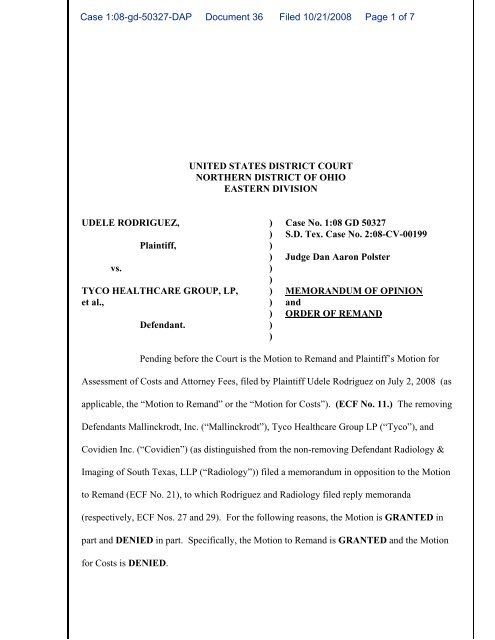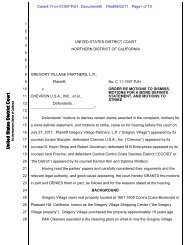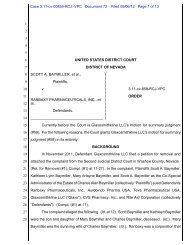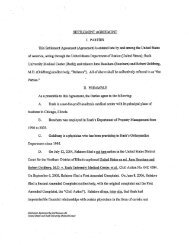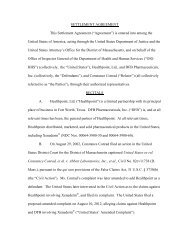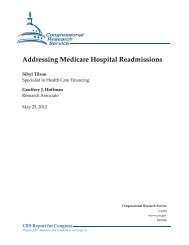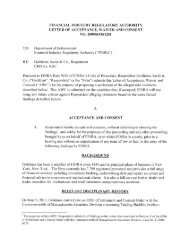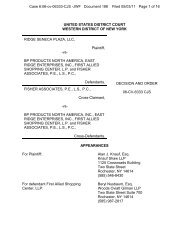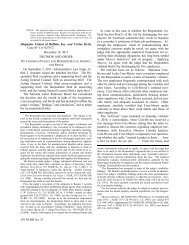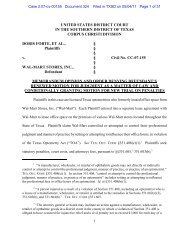S:\ORDERS\Gadolinium MDL\Rodriguez remand order.wpd - BNA
S:\ORDERS\Gadolinium MDL\Rodriguez remand order.wpd - BNA
S:\ORDERS\Gadolinium MDL\Rodriguez remand order.wpd - BNA
Create successful ePaper yourself
Turn your PDF publications into a flip-book with our unique Google optimized e-Paper software.
Case 1:08-gd-50327-DAP Document 36 Filed 10/21/2008 Page 1 of 7<br />
UNITED STATES DISTRICT COURT<br />
NORTHERN DISTRICT OF OHIO<br />
EASTERN DIVISION<br />
UDELE RODRIGUEZ, ) Case No. 1:08 GD 50327<br />
) S.D. Tex. Case No. 2:08-CV-00199<br />
Plaintiff, )<br />
) Judge Dan Aaron Polster<br />
vs. )<br />
)<br />
TYCO HEALTHCARE GROUP, LP, ) MEMORANDUM OF OPINION<br />
et al., ) and<br />
) ORDER OF REMAND<br />
Defendant. )<br />
)<br />
Pending before the Court is the Motion to Remand and Plaintiff’s Motion for<br />
Assessment of Costs and Attorney Fees, filed by Plaintiff Udele Rodriguez on July 2, 2008 (as<br />
applicable, the “Motion to Remand” or the “Motion for Costs”). (ECF No. 11.) The removing<br />
Defendants Mallinckrodt, Inc. (“Mallinckrodt”), Tyco Healthcare Group LP (“Tyco”), and<br />
Covidien Inc. (“Covidien”) (as distinguished from the non-removing Defendant Radiology &<br />
Imaging of South Texas, LLP (“Radiology”)) filed a memorandum in opposition to the Motion<br />
to Remand (ECF No. 21), to which Rodriguez and Radiology filed reply memoranda<br />
(respectively, ECF Nos. 27 and 29). For the following reasons, the Motion is GRANTED in<br />
part and DENIED in part. Specifically, the Motion to Remand is GRANTED and the Motion<br />
for Costs is DENIED.
Case 1:08-gd-50327-DAP Document 36 Filed 10/21/2008 Page 2 of 7<br />
I. BACKGROUND<br />
This case is one of myriad cases pending before the Court as a result of transfer<br />
pursuant to the multi-district litigation entitled In re: Gadolinium-Based Contrast Agents<br />
Products Liability Litigation, MDL No. 1909, Case No. 1:08-GD-50000. Gadolinium-based<br />
contrast agents (“GBCAs”) are used to provide the contrast in magnetic resonance scans<br />
(otherwise known as MRIs or MRAs). The plaintiffs in these MDL cases are generally<br />
individuals (or estates of deceased individuals) who developed a disease known as Nephrogenic<br />
Systemic Fibrosis (“NSF”) following the administration of GBCAs manufactured and/or sold by<br />
one or more of the named defendants in these cases.<br />
In this particular case, Udele Rodriguez (a Texas citizen) is a 26 year old female<br />
who alleges that she contracted NSF following at least four different injections of the GBCA<br />
called OptiMARK, which is manufactured by Defendants Mallinckrodt, Tyco and Covidien (the<br />
“Pharmaceutical Defendants”) and was administered by Radiology. On May 14, 2008,<br />
Rodriguez filed this case in County Court of Nueces County, Texas, alleging various product<br />
liability claims against the Pharmaceutical Defendants. The complaint also contains claims for<br />
medical negligence and failure to obtain informed consent against Defendant Radiology (a Texas<br />
citizen).<br />
On June 29, 2008, the Pharmaceutical Defendants, without the consent of<br />
Radiology, removed the case to federal court based on diversity jurisdiction. Despite the<br />
obvious lack of diversity on the face of the complaint (i.e., Rodriguez and Radiology both being<br />
citizens of Texas), the Pharmaceutical Defendants asserted that diversity of citizenship existed<br />
nonetheless because Radiology was either fraudulently joined or misjoined. The Pharmaceutical<br />
-2-
Case 1:08-gd-50327-DAP Document 36 Filed 10/21/2008 Page 3 of 7<br />
Defendants’ position rests on two different contentions. First, a defendant is fraudulently joined<br />
when the plaintiff cannot establish a cause of action against the non-diverse party in state court.<br />
(Notice of Removal 11 (citing Travis v. Irby, 326 F.3d 644, 647 (5th Cir. 2003).) Rodriguez<br />
cannot state a claim against Radiology because her assertion that the Pharmaceutical Defendants<br />
failed to advise Radiology of the harmful effects of OptiMARK is incompatible with her<br />
assertion that Radiology knew or should have known that OptiMARK was harmful and<br />
concealed that knowledge from her. (Id. 15 (citing In re Baycol Prods. Litig., No. MDL 1431<br />
(MJD) 02-4835, 2003 WL 21223842, at *2 (D. Minn. May 27, 2003).) Second, the<br />
Pharmaceutical Defendants argue that Rodriguez “misjoined” the claims against Radiology with<br />
the product liability claims against the Pharmaceutical Defendants – and they ask the Court to<br />
sever and <strong>remand</strong> the claims against Radiology to effectuate diversity jurisdiction and thwart<br />
<strong>remand</strong> of the entire case. (Notice of Removal 18-26.) Apparently, the Pharmaceutical<br />
Defendants did not bother to obtain the required consent of Radiology before removing the case<br />
because of their position that it is fraudulently joined or misjoined.<br />
II.<br />
Removal of a state court action under 28 U.S.C. § 1441 is proper only if the<br />
action could have originally been filed in federal court. Chase Manhattan Mortg. Corp. v. Smith,<br />
507 F.3d 910, 914 (6th Cir. 2007) (quoting Caterpillar Inc. v. Williams, 482 U.S. 386, 392<br />
(1987)). Federal court has original jurisdiction of all civil actions where the matter in<br />
controversy exceeds $ 75,000 and is between citizens of different states. 28 U.S.C. § 1332(a)(1).<br />
Diversity jurisdiction requires complete diversity – the citizenship of each plaintiff must be<br />
diverse from the citizenship of each defendant. Caterpillar Inc. v. Lewis, 519 U.S. 61, 68<br />
-3-
Case 1:08-gd-50327-DAP Document 36 Filed 10/21/2008 Page 4 of 7<br />
(1996); Coyne ex rel. Ohio v. American Tobacco Co., 183 F.3d 488, 492 (6th Cir. 1999) (quoting<br />
SHR Ltd. Partnership v. Braun, 888 F.2d 455, 456 (6th Cir. 1989)). Title 28, U.S.C. § 1447(c)<br />
provides that a case removed from state court should be <strong>remand</strong>ed if it appears that it was<br />
removed improvidently. The removing party carries the burden of establishing diversity<br />
jurisdiction. Coyne, 183 F.3d at 493 (citing Certain Interested Underwriters at Lloyd’s London,<br />
England v. Layne, 26 F.3d 39, 41 (6th Cir. 1994)). In <strong>order</strong> for a notice of removal to be<br />
properly before the court, the “rule of unanimity” requires that all defendants who have been<br />
served or otherwise properly joined in the action must either join in the removal, or file a written<br />
consent to the removal. Harper v. AutoAlliance Intern., Inc., 392 F.3d 195, 201 (6th Cir. 2004).<br />
Most importantly, the removal statutes are to be strictly construed. Alexander, 13 F.3d at 949<br />
(citing Wilson v. U.S. Dep’t. of Agric., 584 F.2d 137, 142 (6th Cir. 1978)).<br />
A.<br />
As a preliminary matter, the Court REMANDS this case to the County Court of<br />
Nueces County, Texas because the Pharmaceutical Defendants did not obtain the consent of all<br />
Defendants before removal. Harper, 392 F.3d at 201. The Pharmaceutical Defendants did not<br />
state whether Radiology had been served at the time of removal and they cannot show that<br />
Radiology was not properly joined for the reasons set forth below. Accordingly, the removal<br />
was defective.<br />
B.<br />
The Court recently issued a decision declining to apply the doctrine of<br />
(fraudulent) misjoinder previously proposed by Mallinckrodt in a sister MDL case and first<br />
articulated in Tapscott v. MS Dealer Serv. Corp., 77 F.3d 1353, 1360 (11th Cir. 1996), abrogated<br />
-4-
Case 1:08-gd-50327-DAP Document 36 Filed 10/21/2008 Page 5 of 7<br />
on other grounds by Cohen v. Office Depot, 204 F.3d 1069 (11th Cir. 2000). See Geffen v. Gen.<br />
Elec. Co., et al., No. 1:08 GD 50212, ECF No. 58 at 5-13 (N.D. Ohio Feb. 19, 2008) (Polster,<br />
D.J.). For the same reasons set forth at length in Geffen, the Court declines to apply that doctrine<br />
here.<br />
The Court also rejects the Pharmaceutical Defendants’ argument that Radiology<br />
was fraudulently joined. The Pharmaceutical Defendants argue that Radiology was fraudulently<br />
joined because there is no reasonable possibility that Rodriguez can recover against Radiology.<br />
This position is premised upon the Pharmaceutical Defendants contention that Rodriguez’<br />
assertions that the Pharmaceutical Defendants’ knowledge, and failure to warn prescribing<br />
entities like Radiology, of the danger of injecting OptiMARK into patients with renal problems<br />
is incompatible with Rodriguez’ claims against Radiology for medical negligence and failure to<br />
obtain Rodriguez’ informed consent. In support of this argument, the Pharmaceutical<br />
Defendants cite Jones v. Am. Home Prods. Corp., 344 F.Supp.2d 500, 506 (E.D. Tex. 2004).<br />
That case is distinguishable.<br />
Jones involved the use of the preservative Thimerosal in vaccines administered to<br />
children; it was brought on behalf of the citizens of Texas against the manufacturers of<br />
Thimerosal as well as three healthcare providers. With respect to the claims against the<br />
healthcare providers, the district court first noted that Texas had recently enacted a statute that<br />
prohibited liability against healthcare providers for damages arising from an immunization<br />
administered to a child, except for injuries resulting from the provider’s own acts of negligence.<br />
Id. at 502 (citing Tex. Fam. Code Ann. § 32.103(b)(Vernon 2002)). The court then discussed<br />
another recent Texas statute that generally limited the types of negligence for which a plaintiff<br />
-5-
Case 1:08-gd-50327-DAP Document 36 Filed 10/21/2008 Page 6 of 7<br />
may recover against healthcare providers. Id. at 502-03 (citing Tex. Rev. Civ. Stat. Ann. art.<br />
4590i § 1.03(a)(3) (Vernon Supp. 2003)). Specifically, the court explained that, in a suit against<br />
a healthcare provider involving a claim based on the failure of the provider to disclose the risk<br />
involved in a medical procedure, the only theory upon which recovery may be had is that of<br />
negligence in failing to disclose the risks or hazards that could have influenced a reasonable<br />
person in making a decision to give or withhold consent. Id. at 503 (citing Tex. Rev. Civ. Stat.<br />
Ann. art. 4590i, § 6.02)). “[U]nder Texas law, it is not enough in a health liability case to show<br />
that there was some risk, however small, and that a defendant failed to warn of it.” Id. There,<br />
the court reviewed every allegation in the complaint and observed that nowhere in the complaint<br />
did the plaintiffs “even hint” that the risks were such that they would have influenced a<br />
reasonable person in making a decision to give or withhold consent. Id.<br />
Here, Rodriguez asserted in her negligence claim against Radiology that<br />
OptiMARK presented “a serious risk of harm to [her], (ECF No. 1-3 105), that this information<br />
“was, or should have been, known to [Radiology] in light of U.S. Food and Drug Administration<br />
warnings and other medical resources” (id.), and that she “would not have purchased, ingested,<br />
agreed to be injected with, and/or consumed” the OptiMARK if she had known of the serious<br />
risks (id. 108). These allegations are not inconsistent with any allegations against the<br />
Pharmaceutical Defendants and plainly survive the standard articulated in Jones. Rodriguez also<br />
asserted that Radiology failed to advise her of the “untoward consequences, risks of harm and<br />
hazards” associated with the injection of OptiMARK, thereby depriving her of the ability to give<br />
informed consent to its use. (Id. 112.) These allegations survive the Jones threshold as well.<br />
-6-
Case 1:08-gd-50327-DAP Document 36 Filed 10/21/2008 Page 7 of 7<br />
Because the Pharmaceutical Defendants cannot show that there is no reasonable<br />
possibility that Rodriguez can recover against Radiology, they have failed to show that<br />
Radiology was fraudulently joined. Accordingly, assuming for the moment that removal was not<br />
defective, the Court would also GRANT the Motion for Remand on the merits.<br />
C.<br />
Finally, Rodriguez seeks costs and attorney fees incurred in briefing the Motion<br />
for Remand. For the same reasons discussed at length in Geffen, the Court finds that no “unusual<br />
circumstances” exist to justify an award of costs and attorney fees in this case. See Geffen, No.<br />
1:08 GD 50212, ECF No. 58 at 12-14 (citing Martin v. Franklin Capital Corp., 546 U.S. 132,<br />
134-36 (2005)). Accordingly, the Court DENIES the Motion for Costs.<br />
III.<br />
To conclude, the Court GRANTS in part and DENIES in part the Motion to<br />
Remand and Plaintiff’s Motion for Assessment of Costs and Attorney Fees (ECF No. 11).<br />
The Motion to Remand is GRANTED because removal of the case to federal court was<br />
defective and, in any event, the removing Defendants cannot show that Radiology was<br />
fraudulently joined or misjoined. Because diversity is not complete, the Court lacks subject<br />
matter jurisdiction over the case which must, therefore, be <strong>remand</strong>ed. The Motion for Costs is<br />
DENIED. The Clerk of Court is hereby directed to REMAND this case in full to the County<br />
Court of Nueces County, Texas.<br />
IT IS SO ORDERED.<br />
/s/Dan Aaron Polster October 21, 2008<br />
Dan Aaron Polster<br />
United States District Judge<br />
-7-


